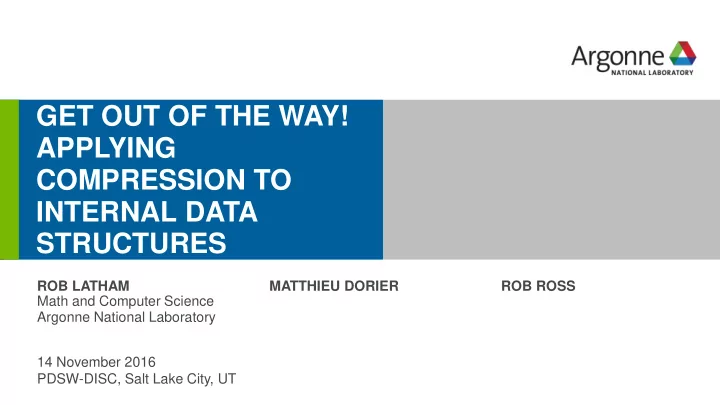

GET OUT OF THE WAY! APPLYING COMPRESSION TO INTERNAL DATA STRUCTURES erhtjhtyhy ROB LATHAM MATTHIEU DORIER ROB ROSS Math and Computer Science Argonne National Laboratory 14 November 2016 PDSW-DISC, Salt Lake City, UT
SYSTEM SOFTWARE AND RESOURCES “Limited amounts of memory and low memory/flop ratios will make processing virtually free. In fact, the amount of memory is relatively decreasing, scaling far worse than computation .” -- Horst Simon Today: two options for system software when memory needs grow “too large”: – Hard error (ENOMEM) – Soak up all memory and laugh at application. Third option: degrade to slower but less memory-intensive approach System Cores/Node RAM/Node RAM//Core Intrepid 4 2 GiB 2 Mira 16 16 GiB 1 Theta 64 16 GiB (MCDRAM) .25 2
ROMIO: EXPECTATIONS VS EXPERIENCE ROMIO processes MPI datatypes by “flattening” – Flattened representation not concise Users only recently running into memory consumption issues – Large vectors – Unstructured “index” types What options can we pursue? 3
MANAGING COMPRESSED CHUNKS • Random access • Maintain one decompressed block https://xgitlab.cels.anl.gov/robl/data_structures 4
ASIDE: BLOSC SHUFFLE IMPACT Blosc framework compresses data, can also shuffle data to make it more compression friendly Straight-up compression: 0.32 8-byte shuffle: 0.02 We used lz4 but easy to switch compression algorithms. http://blosc.org/ Shuffled bytes 5
APPROACH: COMPRESSED FLATTENING Replace C arrays with either comparray or gramarray: – Before: • ADIO_Offset index[], blocklengths[] • index[i] = j; • blocklengths[i] = next; – After: • comparray index, blocklengths • ADIOI_Flatlist_index_set(flat, i, j); • ADIOI_Flatlist_blocklens_set(flat, i, next); – Convenience routines on top of ROMIO-level caching • ROMIO access pattern either runs through linearly or repeatedly consults a small number of elements 6
EXISTING APPROACH: NOT A PROBLEM… UNTIL IT IS Zoomed-in 7
COMPARRAY CPU COST 8
COMPRESS EVEN HARDER Many (not all) MPI datatypes regular patterns Can describe with a (compact) grammar Significantly more expensive original : {0, 4, 12, 16, 24, 28} Significantly higher compression relative : {0, 4, 8, 4, 8, 4} – Except for irregular descriptions (next slide) Interface only allows for (forward/backward) 2 A S 0 , , 4 iteration – Fine for ROMIO. Maybe too restrictive for A 4 , 8 others? Gramarray: https://bitbucket.org/mdorier/gramarray 9
WORKLOADS Hdf5 “big -io ” Constructs a large vector-of-resized type: Peak Memory Execution Time unmodified MPICH 62,700 MiB 66.88 sec Compressed array 706.8 MiB 84.15 sec Gramarray 26.56 MiB 2008 sec 10
WORKLOADS MOAB unstructured mesh conversion A worst-case workload: – Too irregular for Grammar-based approach – Not big enough for compressed approach to benefit Peak Memory Execution Time Unmodified MPICH 213136 KiB 0.28 sec Compressed Array 214272 KiB 0.36 sec Grammarray 214624 KiB 0.56 sec 11
WHAT’S NEXT? Replace more ROMIO arrays with compressed-arrays – Tunable threshold before flipping over to compressed version Will it work in other contexts? – Compressed-arrays: https://xgitlab.cels.anl.gov/robl/data_structures – Gramarray: https://bitbucket.org/mdorier/gramarray 12
Recommend
More recommend